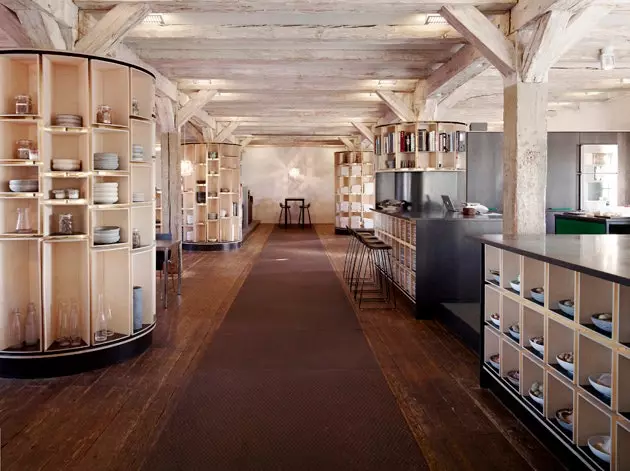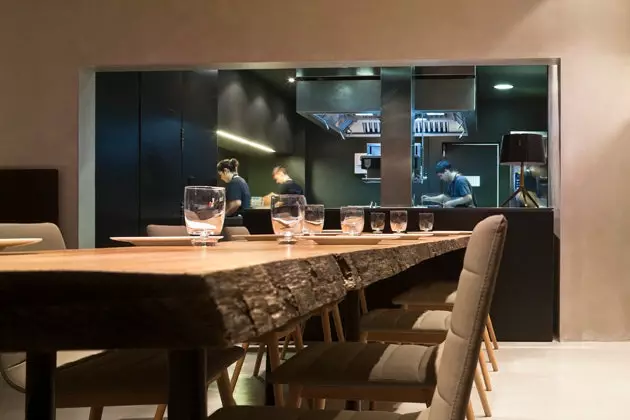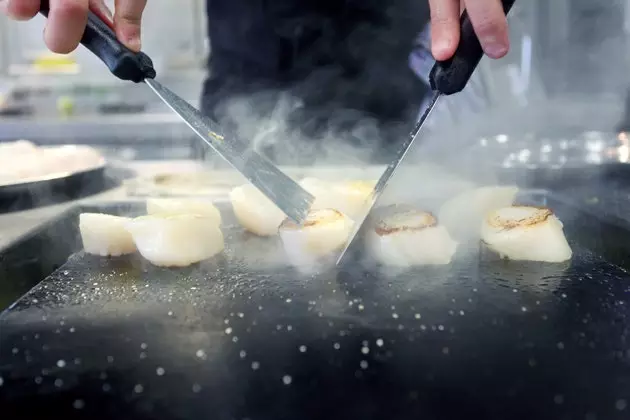
The laboratory of pleasure
The party began in August 2003. That month (exactly on the 10th) Spanish gastronomy touched the sky with Ferran Adria sporting liquid ravioli on the front page of the New York Times and a 14 (fourteen!) page tribute to the 'Alchemist'. We were the Kings of the party. We uproot the scepter (and what is more important, the laurels) of world gastronomy from La France and the almost exhausted post Nouvelle Cuisine of michel braz, Gagnaire either Troisgros . It was our moment.
Under the long media shadow of Ferran sheltered the greats ( arkaz, Subijana either ruscadella , the world's first woman with 3 Michelin Stars in 2005) and also the new breed of cutting-edge hungry puppies and stars. Arola, Dacosta, Roncero, Aduriz or the Rock they were taking off and Paris was a party. Sorry, Spain was a party.
Spanish cuisine did not look back. According to New York chef Daniel Boulud, “in Spain, nobody feels nostalgic. In France, everything is nostalgia.” That attitude (wonderful in its lights) also had the shadows of it. And it is that under the warm mantle of the success of a few astrochefs (full tables, covers and tables of the law disguised as a tasting menu) hundreds, thousands of restaurants flourished with "desire to" and whips to go home. Every week, a new restaurant. A new chef with the pretense of gastronomy genius (all with the sign 'Our chef worked at El Bulli', all-two) and an increasingly spectacular, more radiant, more overwhelming restaurant.
A FLY IN THE SOUP
The sector was unleashed and so were (bad business) investors. Gastronomy ceased to be the heritage of families linked after generations to the kitchen and the financial sector put its magnifying glass (and its credit) on the gleaming stainless steel kitchens. many wondered, "why not refurbish my restaurant?" This was the case of Torrijos or Ca'Sento and the €300,000 reform under the baton of the star architect of the day. Today is closed.
It was the moment of spherifications, vacuum cooking, foams and emotional technocuisine. We journalists (mea culpa) stop talking about cooking and our speech dressed in pretty words : architecture, trend, art, avant-garde. The photographs were no longer of dishes, they were of lamps by Philippe Starck or paintings by Mariscal. They were no longer restaurants. They were “gastronomic spaces”. When you asked about the chef, he would tell you the story of the metaphor behind those white wooden sheets on the wall or the reason for the mirror on the ceiling. At what point do we forget food?
There was business. That is why the hotels (the big ones and the not so big ones) embraced the gastro sector and the race for the most brilliant signing began. Behind every hotel, an essential restaurant. Dos Cielos at the ME, Ramón Freixa at the Hotel Único, Bravo at the W, Arrop at the Hotel Caro, Paco Pérez at the Arts, Santceloni at the Hesperia... But how many essential restaurants fit in a house in ruins?
THE GASTRO-TURN OF THE SCREW
Write down another date in this story, July 2008. José Carlos Capel writes for the first time the term 'gastrobar' (importing the concept 'gastropub' from the English guide Time Out) with regard to Pure state (perhaps the second gastrobar after Inopia de Albert Adria ) .
Remember the headline: Haute cuisine was unsustainable . It had to be made profitable and the street was called gastrobar, second (and first, so many times) brands of great chefs in low-cost formats. Gone are the happy days of "there is no longer a table" in the menus of a hundred and something turkeys. Blame for the crisis? Blame it on excess supply? Is it the fault of the restaurant-operetta or the fault of the diner who did not understand anything? Haute cuisine slid (at least in part of public opinion) from avant-garde to frivolous, and in so many cases ended up being a caricature of itself. Francis Paniego told us “The changes that avant-garde cuisine has experienced in our country in recent years have been, for many, difficult to understand, and for some even highly caricatured. We cooks try to get away from a frivolous image that some insist on giving us.”
More is more is over. The excessive and apparent baroque restaurant is over. Gone are the snobby maîtres, bow ties and five forks. The luxury of the inaccessible (caviar, eels, bluefin tuna or white truffles) has come to an end and a new way of looking, of being, of eating has made its way.
WOOD, VEGETABLES AND SLIPPERS
May 2010. Noma is elected the best restaurant in the world by Restaurant Magazine and it does so in front of elBulli (not after elBulli, but in front of elBulli, which is not the same thing) the speech of Rene Redzepi It speaks of avant-garde but also of sustainability, purity, minimalism, local cuisine and commitment. The new Nordic cuisine enters the scene and the Copenhagen butterfly unleashes with its wings a silent and necessary tsunami. A new luxury. “Nordic gastronomy is an everyday cuisine that inspires you to eat local products. It's about tradition and eating garden produce in a new context." he says so Trina Hahneman , author The Scandinavian Cookbook .
East new luxury substitutes pomp and gold for wood, space and nudity . This Nordic style flees from the exuberant and seeks to impress without dazzling. The connection with the person through natural materials (wood, stone, leather) and a setting that is not intended to be your cathedral but your home. Silence in front of piped music. The fireplace in front of the lamp Starck.
Carolina returns, Tondeluna, Canalla Bistro, Atrium either Nerua they are today the reflection of this new (which is actually old) essential way of understanding gastronomy and its environment. A now which has also meant sweeping changes in how (and why) restaurants dress.

Ricard Camarena, wood and naturalness
LET'S TALK ABOUT INTERIOR DESIGN
We spoke with Francesc Rifé, an interior designer based in Barcelona responsible for the gastronomic proposals of Ricard Camarena (Ricard Camarena restaurant, Canalla Bistró and Centra Bar) and his restaurant in Valencia is, as is, the reproduction of a house:
- Concrete, microcement, wood and noble materials, is that the way? For us it is a philosophy, few and natural, just like his cooking: easy to understand. A trend of global style and at the same time neutral, very humble, just like the kitchen and the person who makes it work.
Eat (almost) like at home. The path from the impersonal to the warmth of a bare table; the product over (excessive) processing. The flavor over artifice. Is this new stage the next logical step of an exhausted period or the response to a (global) crisis of values?
Answers . Next week (February 6) kicks off the 2013 season for Quique Dacosta (who, by the way, dispensed with the tablecloth three years ago), on March 13 Paco Morales (nature's cook) and Mugaritz will do it in April. That means that the tournée of foodies, gastronomic critics and enjoyers through the map of the great (and small) restaurants of Spain begins. Since aponiente until Lakasa , since Dog Rock until doll , since plaice house until L´Escaleta . Answers.
I only expect honesty. On the plate and in the room.
Do not stop the party.
*You may also be interested in...
- All the articles of Jesús Terrés
- Tablecloth and knife

Simplicity, what's next
